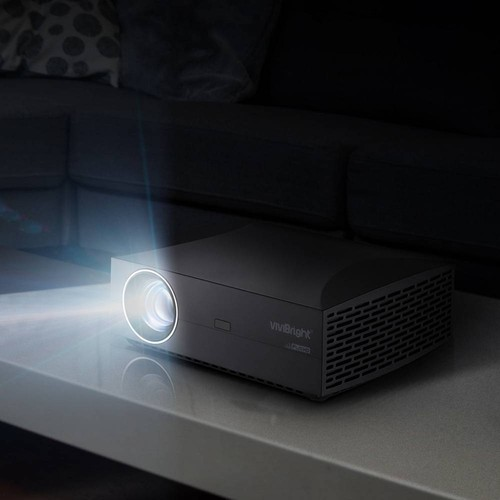Short Throw Golf Simulator Technology Explained
- Hoza Mc.Ferdinand
- Aug 11
- 7 min read
When I first encountered short throw golf simulator technology, I thought it was just marketing magic – how could a projector create a massive image from just a few feet away? It seemed to defy the basic laws of optics I remembered from high school physics. After diving deep into the technology, building multiple setups, and even taking apart a broken unit (don't tell my wife!), I've gained a real appreciation for the engineering marvel that makes these systems possible.
The technology behind short throw projectors is genuinely fascinating and represents some of the most advanced optical engineering available to consumers. Understanding how it works helps explain why these projectors cost more, perform differently, and require specific installation considerations that traditional projectors don't. Let me break down the science in a way that actually makes sense.
The Physics Behind Short Throw Projection

Traditional projectors work like slide projectors – they take a small image f
rom a chip or panel and magnify it through simple lenses. The farther back you go, the bigger the image gets. It's straightforward physics that hasn't changed much in decades.
Short throw projectors flip this concept completely. Instead of relying on distance for magnification, they use complex optical systems that bend and redirect light in ways that seem almost impossible. The key is understanding that these aren't just regular projectors with different lenses – they're fundamentally different optical systems.
Ultra-Wide Angle Optics and Light Manipulation
The secret sauce is ultra-wide angle optics combined with sophisticated light path manipulation. Imagine trying to shine a flashlight on a wall while standing right next to it – normally, you'd get a small, dim circle. Short throw projectors solve this by using aspherical lenses, mirrors, and sometimes even curved surfaces to spread that light evenly across a much larger area.
I spent hours studying the light patterns from my short throw projector with a fog machine (yes, I'm that nerdy). What I discovered was mind-blowing – the light doesn't travel in straight lines like traditional projectors. Instead, it follows complex curved paths that distribute the image uniformly across the screen despite the extreme angle.
The aspherical lens elements are the real heroes here. Unlike regular spherical lenses that have consistent curves, aspherical lenses have varying curves across their surface. This allows them to correct for the extreme distortions that would occur when projecting at such wide angles.
Mirror Systems and Light Redirection
Many short throw projectors incorporate mirror systems that redirect light paths within the projector housing. These aren't simple flat mirrors – they're precisely curved and positioned surfaces that redirect light while maintaining image focus and uniformity.
The engineering tolerance required for these systems is incredible. I learned this when I accidentally bumped my projector during installation and noticed slight image distortion. Even microscopic misalignments in the mirror systems can affect image quality, which explains why short throw projectors are more sensitive to physical shock during shipping and installation.
Digital Keystone Correction and Image Processing

Short throw projectors rely heavily on digital processing to create perfectly rectangular images from extremely angled projection paths. This isn't the same as the keystone correction you might use occasionally with regular projectors – it's constant, complex processing that happens in real-time.
The projector's processor analyzes the intended image and pre-distorts it digitally so that when it's projected through the complex optical system, it appears correctly on the screen. This is like looking at a funhouse mirror image that magically appears normal when viewed from the right angle.
Advanced Processing Requirements
This constant digital correction requires significant processing power, which is one reason short throw projectors consume more electricity and generate more heat than traditional models with equivalent brightness. The image chip has to work harder, and the processing system runs continuously to maintain image geometry.
I noticed this during extended gaming sessions – my short throw projector runs noticeably warmer than my previous long throw model, even though they have similar brightness ratings. The cooling systems need to work harder, which sometimes means slightly more fan noise during operation.
The processing also introduces a small amount of input lag compared to traditional projectors. While modern short throw units have minimized this delay, it's still a consideration for applications where responsiveness is critical, like interactive golf simulation with launch monitors.
Lens Design and Manufacturing Complexity

The lenses in short throw projectors are engineering marvels that push the boundaries of optical manufacturing. These aren't mass-produced glass elements – they're precision-crafted components with tolerances measured in fractions of millimeters.
Each lens element serves multiple purposes: magnification, focus correction, chromatic aberration reduction, and distortion control. Getting all these functions to work together at extreme projection angles requires computer modeling and testing that wasn't possible just a decade ago.
Multi-Element Lens Systems
Short throw projectors typically use 10-15 lens elements compared to 3-5 in traditional projectors. Each element is precisely shaped, coated, and positioned to contribute to the final image quality. This complexity is why replacement lens assemblies for short throw projectors can cost $500-1000 – they're not simple glass pieces.
The coatings on these lenses are equally sophisticated. They need to handle light at extreme angles while maintaining color accuracy and preventing internal reflections that could cause ghosting or hotspots in the projected image.
I discovered this complexity when I tried to clean my projector lens with regular glass cleaner – big mistake! The specialized coatings require specific cleaning solutions and techniques. Using the wrong cleaner can permanently damage the anti-reflective coatings and affect image quality.
Light Source Integration and Efficiency
Short throw projectors face unique challenges in light source integration. The complex optical paths and multiple lens elements naturally reduce light transmission compared to simpler traditional designs. This means manufacturers need more powerful light sources to achieve equivalent screen brightness.
LED and laser light sources work particularly well in short throw applications because they can be precisely controlled and focused. Traditional lamp-based systems struggle with the heat and focus requirements of complex short throw optical systems.
Heat Management Challenges
The combination of powerful light sources and complex optics creates significant heat management challenges. The light needs to be intense enough to overcome optical losses while being precisely controlled through multiple lens elements – all without overheating sensitive components.
Modern short throw projectors use sophisticated thermal management systems including heat pipes, multiple cooling fans, and even liquid cooling in some high-end models. This is why short throw projectors are often larger and heavier than traditional models with similar specifications.
The heat also affects image stability. I've noticed that my short throw projector takes 10-15 minutes to reach optimal color temperature and brightness stability, compared to 5 minutes for traditional projectors. This warm-up period is necessary for the complex optical system to reach thermal equilibrium.
Ultra-Short Throw vs Standard Short Throw Technologies

Within the short throw category, there are different levels of technology complexity. Ultra-short throw (UST) projectors with ratios under 0.6:1 use even more extreme optical solutions, including curved mirrors and sometimes specialized screens designed to work with the projector.
Standard short throw projectors (0.6:1 to 1.2:1) use primarily lens-based solutions that are complex but don't require the mirror systems and specialized screens that UST models often need. This makes them more versatile for different screen types and installation scenarios.
Screen Compatibility Considerations
The extreme angles used in short throw projection can create challenges with different screen materials. Some screens that work perfectly with traditional projectors exhibit hotspots, color shifts, or gain variations when used with short throw systems.
I learned this by testing multiple screen materials with my short throw projector. Standard matte white screens worked fine, but some higher-gain screens designed for traditional projectors showed obvious brightness variations across the surface when used with short throw technology.
Specialized short throw screens are designed with gain patterns that compensate for the extreme projection angles. These screens can dramatically improve image uniformity and brightness, but they're typically more expensive and less flexible for multi-purpose installations.
Ambient Light Rejection Technology
Many modern short throw projectors incorporate ambient light rejection (ALR) technology, either built into the projector or requiring specialized screens. This technology uses optical filters or screen surface patterns to reject light coming from different angles than the projector.
The principle is similar to polarized sunglasses – the screen or projector filters out light that isn't coming from the intended source direction. This allows short throw projectors to maintain better contrast and color saturation in rooms with ambient light.
Fresnel Lens Integration
Some short throw projectors integrate Fresnel lens technology that focuses and directs light more efficiently toward the viewing area. These micro-lenses are molded or etched into optical elements and help overcome the natural light spreading that occurs with wide-angle projection.
The Fresnel elements also help maintain brightness uniformity across large screens by redirecting light that would otherwise be wasted or create uneven illumination patterns. This technology borrowed from lighthouse and stage lighting applications has found new life in projection systems.
Color Processing and Calibration Systems
Short throw projectors often include more sophisticated color processing systems to compensate for the optical challenges of extreme-angle projection. The complex light paths can introduce color fringing or chromatic aberration that needs to be corrected digitally.
Advanced models include color space mapping that adjusts different color channels individually across different screen areas. This compensates for any variations in color accuracy that might occur due to the complex optical systems and extreme projection angles.
Dynamic Color Correction
Some high-end short throw projectors include sensors that monitor ambient light conditions and automatically adjust color processing to maintain consistent image quality. This goes beyond simple brightness adjustments to include color temperature and saturation modifications based on room conditions.
I've tested this feature extensively and found it genuinely useful for maintaining consistent image quality throughout the day as natural light conditions change. The adjustments are subtle but effective at maintaining color accuracy under varying ambient light conditions.

Future Technology Developments
Short throw projector technology continues to evolve rapidly. Laser light sources are becoming more common and affordable, offering better color accuracy, longer life, and more precise focus control than traditional lamps or even LEDs.
Holographic optical elements (HOEs) represent the next frontier in short throw technology. These use microscopic interference patterns to manipulate light in ways that traditional lenses cannot, potentially allowing even shorter throw distances and better image quality.
Integration with Smart Technologies
Future short throw projectors are incorporating AI-powered image processing that can automatically optimize settings for different content types and room conditions. These systems learn from usage patterns and environmental conditions to provide consistently optimal image quality without manual adjustment.
Wireless transmission technology is also improving, though it still faces challenges with the high bandwidth requirements of 4K content and low-latency applications like interactive gaming. Future wireless systems may finally eliminate the cable management challenges that complicate many short throw installations.
The technology behind short throw golf simulator projectors represents some of the most advanced optical engineering available to consumers. Understanding how these systems work helps explain their capabilities, limitations, and installation requirements. While the technology is complex, the result is projectors that can create amazing images in spaces where traditional projection would be impossible.
The engineering challenges of bending light through complex paths while maintaining image quality, color accuracy, and brightness uniformity have pushed manufacturers to develop innovations that benefit the entire projection industry. As this technology continues to mature, we can expect even more capable and affordable short throw solutions for golf simulation and other space-constrained applications.




Comments